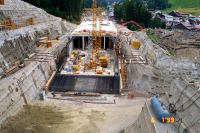St. Anton a. Arlberg Railway Relocation
Client: Austrian Railways
Development Period: 1997 to 2001
Due to the immediate demands of hosting the Alpine Skiing World Cup 2001, the railway connection between St. Jakob a.A. and St. Anton a.A. had to be upgraded to a two track line. The project entailed the following: The existing railway track was relocated to the opposite side of the valley (in order to enable unhindered access from the village to the adjacent skiing regions); One additional railway track was added; The Wolfsgruben Tunnel was excavated; The Arlberg Tunnel was extended; The new track was linked with the existing Arlberg Tunnel; Lastly, the St. Anton railway station was completely rebuilt.
The project had to be realized within a short time-frame and with consideration of extreme weather conditions.
BGG oversaw the project through all the planning and building phases in the field of geology, geotechnics and hydrogeology. This included first of all the geological mapping, and the coordination and supervision of several subsoil exploration campaigns. Due to time restraints, only a limited number of drilling results could be obtained. Matters such as the securing of building pits and foundations, the dimensioning of the retaining structures, and the planning of the landfills had to be resolved in close cooperation with the project planners. For the area of the tunnel where the mining technique was used, BGG provided the geological, hydrogeological and geomechanical basics. In addition, the hydrogeological preservation of evidence was carried out.
Wolfsgruben Tunnel:
For the construction of the Wolfsgruben Tunnel the cut and cover method was employed. Building pits with a depth of up to 45 m were secured. Furthermore, a soil exchange of up to 2.5 m was necessary, which had to be dumped and tested in the winter season. Along the section of the tunnel that was excavated using the mining technique, tectonic fault areas and creeping slopes had to be crossed. This required special measures such as horizontal anchoring and support piles for the tunnel crown.
In this project, especially due to severe time limitations, appropriate geotechnical consulting played a crucial role in providing the necessary safety and economic success.
April 2001
